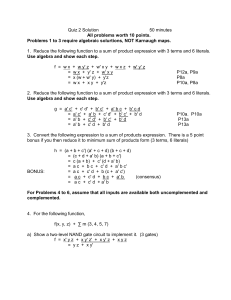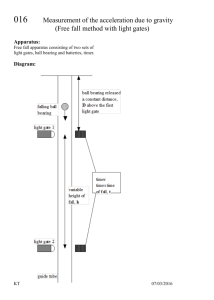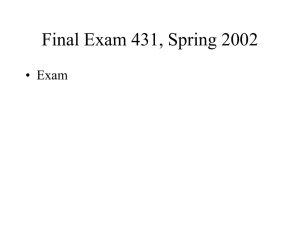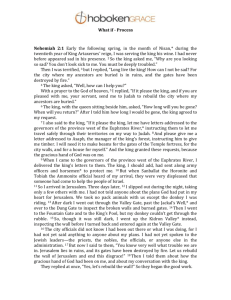Tech Tips T Accessible Gates for Trails and Roads Highlights…
advertisement
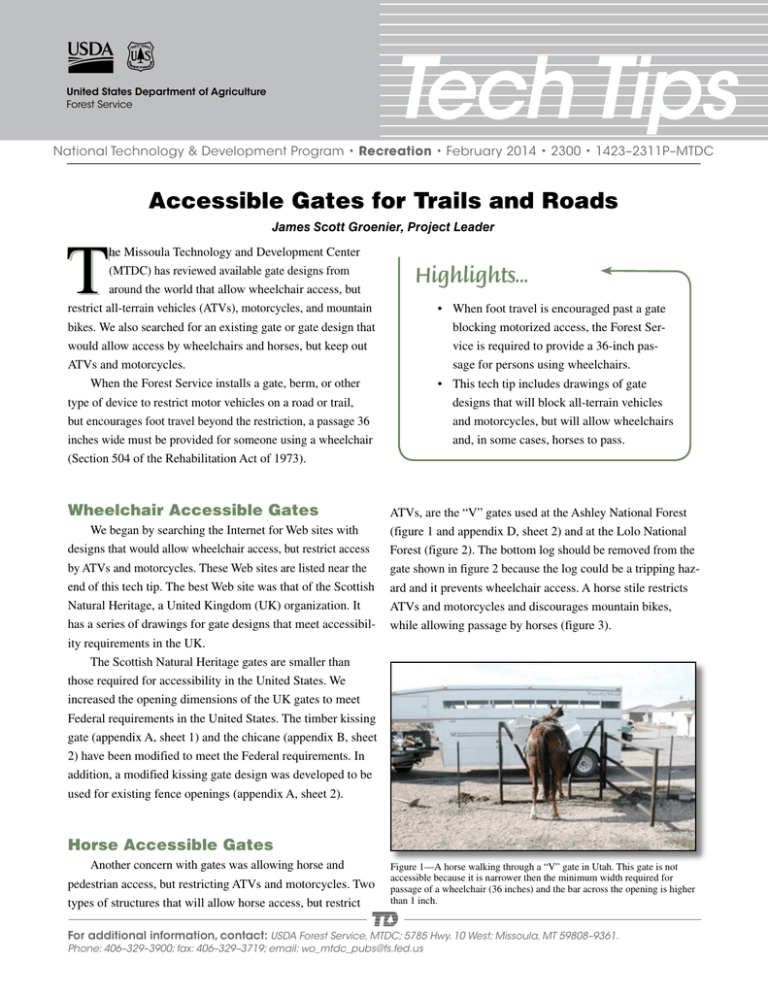
Tech Tips United States Department of Agriculture Forest Service National Technology & Development Program • Recreation • February 2014 • 2300 • 1423–2311P–MTDC Accessible Gates for Trails and Roads T James Scott Groenier, Project Leader he e Missoula Technology and Development Center (MTDC) has reviewed available gate designs from around the world that allow wheelchair access, but restrict all-terrain vehicles (ATVs), motorcycles, and mountain bikes. We also searched for an existing gate or gate design that would allow access by wheelchairs and horses, but keep out Highlights… • When foot travel is encouraged past a gate blocking motorized access, the Forest Service is required to provide a 36-inch passage for persons using wheelchairs. • This tech tip includes drawings of gate designs that will block all-terrain vehicles and motorcycles, but will allow wheelchairs and, in some cases, horses to pass. ATVs and motorcycles. When the Forest Service installs a gate, berm, or other type of device to restrict motor vehicles on a road or trail, but encourages foot travel beyond the restriction, a passage 36 inches wide must be provided for someone using a wheelchair (Section 504 of the Rehabilitation Act of 1973). Wheelchair Accessible Gates We began by searching the Internet for Web sites with designs that would allow wheelchair access, but restrict access by ATVs and motorcycles. These Web sites are listed near the end of this tech tip. The best Web site was that of the Scottish Natural Heritage, a United Kingdom (UK) organization. It has a series of drawings for gate designs that meet accessibility requirements in the UK. The Scottish Natural Heritage gates are smaller than those required for accessibility in the United States. We increased the opening dimensions of the UK gates to meet Federal requirements in the United States. The timber kissing gate (appendix A, sheet 1) and the chicane (appendix B, sheet 2) have been modified to meet the Federal requirements. In addition, a modified kissing gate design was developed to be used for existing fence openings (appendix A, sheet 2). ATVs, are the “V” gates used at the Ashley National Forest (figure 1 and appendix D, sheet 2) and at the Lolo National Forest (figure 2). The bottom log should be removed from the gate shown in figure 2 because the log could be a tripping hazard and it prevents wheelchair access. A horse stile restricts ATVs and motorcycles and discourages mountain bikes, while allowing passage by horses (figure 3). Horse Accessible Gates Another concern with gates was allowing horse and pedestrian access, but restricting ATVs and motorcycles. Two types of structures that will allow horse access, but restrict Figure 1—A horse walking through a “V” gate in Utah. This gate is not accessible because it is narrower then the minimum width required for passage of a wheelchair (36 inches) and the bar across the opening is higher than 1 inch. For additional information, contact: USDA Forest Service, MTDC; 5785 Hwy. 10 West; Missoula, MT 59808–9361. Phone: 406–329–3900; fax: 406–329–3719; email: wo_mtdc_pubs@fs.fed.us together because the required turning diameter for a wheelchair is 60 inches. This corresponds to the minimum required spacing of the stiles for horses to step over them in stride. The stile should be no higher than 12 inches because horses may jump over stiles that are higher. Road Closure Drawings Figure 2—A gate in the Lolo National Forest that allows horses to pass, but restricts ATVs. This gate is not accessible because it is narrower than the minimum width required for passage of a wheelchair (36 inches) and the bar across the opening is higher than 1 inch. Many forest roads are closed to motor vehicle traffic by gates or other types of barriers. Often, foot travel is allowed beyond the restriction device. When foot travel is actually encouraged on the other side of the barrier, passage for someone in a wheelchair must be provided. The road closure drawings (appendix C, sheets 1 and 2) show four different ways to allow wheelchair access around a road closure gate, while restricting ATV use. Another concern is not having enough room to allow both horse and wheelchair access around a road closure barrier. This may be remedied by installing an accessible gate for wheelchair access (see appendix C, sheets 1 and 2) and replacing the road gate with a horse-friendly barrier (appendix C, sheet 3). The kissing gate may be added adjacent to a cattleguard on a road to allow wheelchair access, while restricting cattle. Signs Figure 3—A horse stile. This gate is not accessible because the bars across the opening are higher than 1 inch. Combination Wheelchair/Horse Accessible Gates The greatest challenge was to find a gate that allowed horses and wheelchairs to pass, but restricted all motorized traffic. The “V” gate design (see appendix D, sheet 2) allows wheelchairs and horses, but only restricts ATVs—not motorcycles. We combined the kissing gate with the horse stile to design the Horse Gate With Wheelchair Accessibility (appendix D, sheet 1). Wheelchairs are able to go into the center of the gate, turn around and go out the other side. Horses can walk over the two stiles. The gate dimensions work well 2 Mountain bikes, motorcycles, and small ATVs may be able to maneuver around obstacles and gates. In these cases, signs should be considered for additional travel management. All signs (including object markers) must meet the requirements of the Sign and Poster Guidelines for the Forest Service (EM 7100–15). Additionally, signs are required when mountain bikes or motorized vehicles are allowed on Forest Service trails. Summary This project developed drawings for gates that meet the accessibility requirements for wheelchairs, horses, or both, but restrict motorized vehicle access. These new gates help the Forest Service fulfill its policy of universal design, providing access to public lands for all people. Web Sites for Gate Designs and Suppliers in the United Kingdom Scottish Natural Heritage http://www.snh.org.uk/publications/on-line/accessguide /gates.asp Bushey and District Footpaths Association (BADFA) http://www.badfa.org/uk/gates&stiles/GATES.htm Centrewire Ltd. http://www.centrewire.com/ Other Related Projects Beneficial Designs, Inc.is working on a project called Accessible Trail Gate Barrier Technologies. Beneficial Designs, Inc. 2240 Meridian Blvd., Suite C Minden, NV 89423 Phone: 775–783–8822 Fax: 775–783–8823 Web site: http://beneficialdesigns.com/products/vehicle -barrier-for-trails Jackson’s Fine Fencing http://www.jacksons-fencing.co.uk/common/search.aspx?s =kissing gates Other Accessibility Web Sites American Trails http://www.americantrails.org/resources/accessible/ National Center on Accessibility http://ncaonline.org/ USDA Forest Service—Accessibility http://www.fs.fed.us/recreation/programs/accessibility/ 3 OS TT O N LE CA Appendix A 4 OS TT NO LE CA Appendix A (continued) 5 OS TT NO LE CA Appendix B 6 OS TT NO LE CA Appendix C 7 OS TT NO CA LE Appendix C (continued) 8 OS TT NO CA LE Appendix C (continued) 9 OS TT O N LE CA Appendix D 10 SCA TO T NO LE Appendix D (continued) 11 Acknowledgments For information and assistance, the author would like to thank: Ellen Eubanks, San Dimas Technology and Development Center; Gina Reese, Ashley National Forest; Donna Sheehy, Northern Region; and Janet Zeller, Washington Office. Thanks to MTDC’s publication and photography staffs, especially Sunni Bradshaw for technical support, Deb Mucci for design drawings, and Geraldine Wolf for editorial assistance. The drawings in this tech tip are available on the Internet at: <http://www.fs.fed.us/recreation/programs/accessibility /pubs/htmlpubs/htm14232311/drawings/> About the Author James Scott Groenier, professional engineer, began working for MTDC as a project leader in 2003. Groenier earned a bachelor’s degree in civil and environmental engineering from the University of Wisconsin at Madison and a master’s degree in civil engineering from Montana State University. He worked for the Wisconsin and Illinois State Departments of Transportation and with an engineering consulting firm before joining the Forest Service in 1992. He worked as the east zone structural engineer for the Eastern Region and as a civil engineer for the Ashley and Tongass National Forests before coming to MTDC. Library Card Groenier, James Scott. 2014. Accessible gates for trails and roads. Tech Tip 1423–2311P–MTDC. Missoula, MT: U.S. Department of Agriculture, Forest Service, Missoula Technology and Development Center. 12 p. This tech tip includes drawings for gates that can be used to close roads and trails to motorized access while still allowing access by wheelchairs and, in some cases, horses. When the Forest Service installs a gate, berm, or other type of restriction to block motorized access but encourages foot access, a passage 36 inches wide must be provided so a person using a wheelchair could get through (Section 504 of the Rehabilitation Act of 1973). This publication replaces tech tip 0623–2340. Keywords: accessibility, all-terrain vehicles, ATVs, chicanes, horses, kissing gates, motorcycles, wheelchairs For additional technical information, contact MTDC: USDA Forest Service Missoula Technology and Development Center 5785 Hwy. 10 West Missoula, MT 59808-9361 Phone: 406–329–3900 Fax: 406–329–3719 Electronic copies of National Technology and Development documents are available on the Internet at: http://www.fs.fed.us/eng/pubs Forest Service and Bureau of Land Management employees can search National Technology and Development documents, CDs, DVDs, and videos on their internal computer networks at: http://fsweb.mtdc.wo.fs.fed.us/search/ http://fsweb.sdtdc.wo.fs.fed.us/ The Forest Service, an agency of the U.S. Department of Agriculture (USDA), has developed this information for the guidance of its employees, its contractors, and its cooperating Federal and State agencies. The Forest Service assumes no responsibility for the interpretation or use of this information by anyone except its own employees. The use of trade, firm, or corporation names is for the information and convenience of the reader. Such use does not constitute an official endorsement or approval of any product or service to the exclusion of others that may be suitable. USDA Non-Discrimination Policy The U.S. Department of Agriculture (USDA) prohibits discrimination against its customers, employees, and applicants for employment on the bases of race, color, national origin, age, disability, sex, gender identity, religion, reprisal, and where applicable, political beliefs, marital status, familial or parental status, sexual orientation, or all or part of an individual’s income is derived from any public assistance program, or protected genetic information in employment or in any program or activity conducted or funded by the Department. (Not all prohibited bases will apply to all programs and/or employment activities.) To File an Employment Complaint If you wish to file an employment complaint, you must contact your agency’s EEO Counselor (http://www.ascr.usda.gov/doc/EEO_Counselor_List.pdf) within 45 days of the date of the alleged discriminatory act, event, or in the case of a personnel action. Additional information can be found online at http://www.ascr.usda.gov/complaint_filing_file.html. To File a Program Complaint If you wish to file a Civil Rights program complaint of discrimination, complete the USDA Program Discrimination Complaint Form, found online at http://www.ascr.usda.gov/complaint_filing_cust.html, or at any USDA office, or call (866) 632–9992 to request the form. You may also write a letter containing all of the information requested in the form. Send your completed complaint form or letter to us by mail at U.S. Department of Agriculture, Director, Office of Adjudication, 1400 Independence Avenue, S.W., Washington, D.C. 20250-9410, by fax (202) 690–7442 or email at program.intake@usda.gov. Persons with Disabilities Individuals who are deaf, hard of hearing or have speech disabilities and you wish to file either an EEO or program complaint please contact USDA through the Federal Relay Service at (800) 877–8339 or (800) 845–6136 (in Spanish). Persons with disabilities who wish to file a program complaint, please see information above on how to contact us by mail directly or by email. If you require alternative means of communication for program information (e.g., Braille, large print, audiotape, etc.) please contact USDA’s TARGET Center at (202) 720–2600 (voice and TDD). 12



